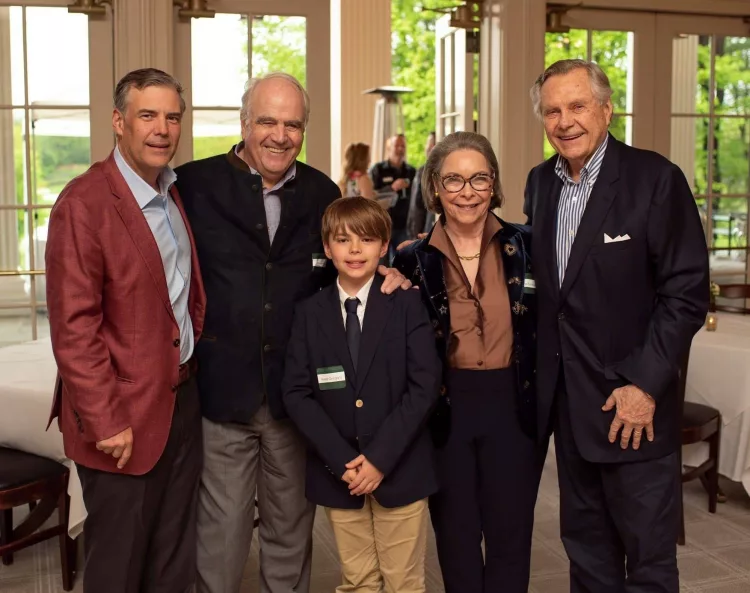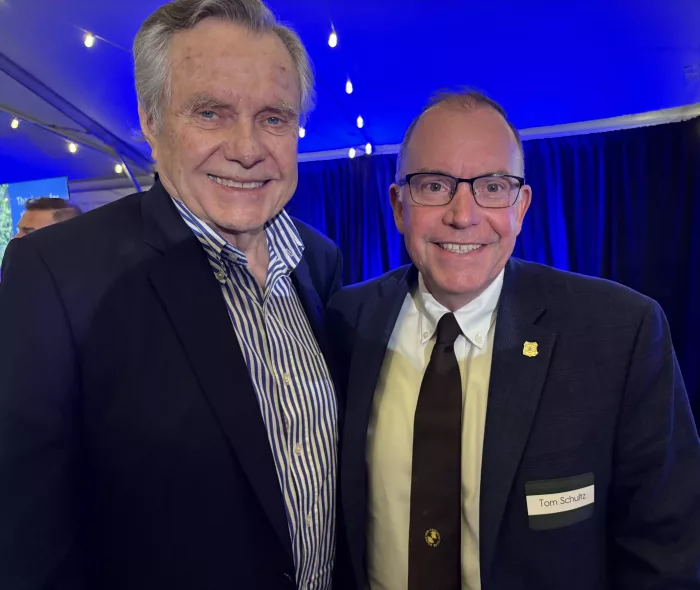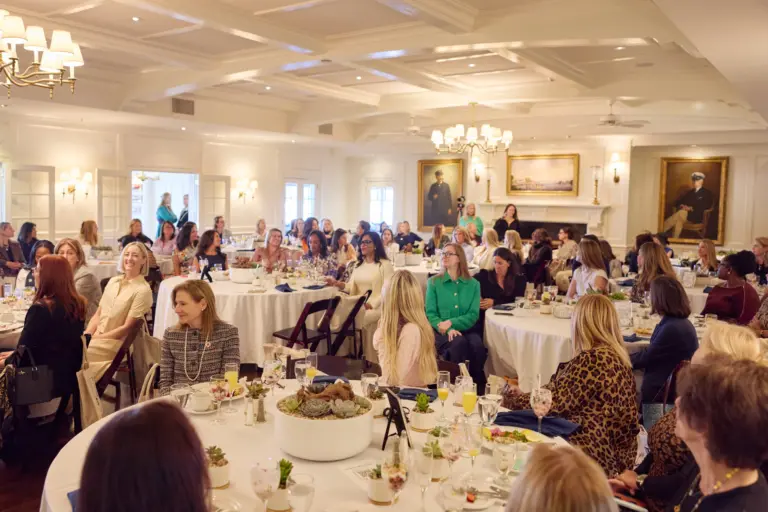
By Anne W. Semmes
Greenwich’s Grant Gregory Sr. was heralded last Friday at the Glen Arbor Golf Club he founded in Bedford Hills, N.Y. for his extraordinary contributions to this country’s National Forest Foundation (NFF) that is committed to supporting our National Forests and Grasslands. Gregory addressed the 130 supporters attending from across the country – with one coming as far as Afghanistan, as “Forest service people who care about nature, who care about the 193 million acres established in 154 National Forests.”
The gathering also celebrated the 30th anniversary of the important NFF fundraising Sporting Clays Invitational, happening the following Saturday in Dover Plains, NY. The sport, often referred to as “golf with a shotgun” has teams of four playing 18 holes, shooting at clay targets.
It was 33 years ago that Gregory with his successful business and bank founding prowess was called upon to help create the non-profit NFF to partner with the U. S. Forest Service. Gregory spelled out that fascinating history in his talk, that began from where he was speaking. “Ironically, in some ways the National Forest started not far from here because on the grounds of Glen Arbor, George Washington’s troops came for air and to lick their wounds …And as soon as he got elected first president he brought in as Chief Justice of the Supreme Court John Jay whose farm is next door.”
“With Jefferson’s arrival,” Gregory continued, he made Jay the Secretary of State with instruction, to “get what is now the Louisiana purchase…bought for $15 million…doubling the western side of the United States.” Fast forward to Teddy Roosevelt who as president moved quickly to consolidate and create even more of a National Forest, “with a huge sense of urgency and knowledge with Gifford Pinchot, if not the most educated forester in that time. He studied forestry in Germany, which was much more advanced than ours…the Germans created the idea of farming forests…harvest them and on an annual basis you replant them.”
Pinchot and Roosevelt would then “sit down on the floor of the White House” with their Crayola’s putting “circles around all the places, where Roosevelt had ever camped, hunted fish, explored what he liked, and they doubled the size of the National Forest overnight…So, thank you Teddy Roosevelt.”
Roosevelt would then move the National Forest out of the Department of Interior into the Department of Agriculture, “because they thought they should be farmed, they should be managed and they should follow the multiple use measures that you could hunt, fish,” and “if you continually improve by best practices, it’s almost like farming…and that was how the National Forest became part of the Agriculture department for continuous improvement.”
Fast forward to the administration of George Herbert Walker Bush ‘41, a friend of Gregory’s. “I had done a lot of work with Reagan and knew him and Bush pretty well. So, he summoned me down to the White House. And there was Senator Pete Dominici and President Bush all agitated. And Bush said, ‘You’ve got to do something…those guys in the National Parks department have got this foundation. They’re just raking in the money. They’ve got these corporate sponsors…We’re four times bigger than the National Parks… We’ve got all this land to use, resources, recreation, and we don’t have any partners. We don’t have enough money to take care of 193 million acres – we’ve got 35,000 employees in the National Forest. We’ve got to get private partnerships going here, we need it done yesterday…Say you form a Foundation, and I’ll back you.”
Gregory reached out to his friends including Donald Kendall, chairman of PepsiCo and Ralph Bailey of Conoco, “and his son is here tonight… Then we formed a board of directors, and we got started and that was 1992… So, we started to get rolling.” And today, “There’s about 950 million visitor days to the National Forest.”
But then came that crisis in Glenwood Springs, Colorado where 14 forest workers died in a forest fire, and others with severe burns with no life insurance. “They didn’t have healthcare or anything,” told Gregory. And Gregory reached out to Foundation supporters. And from that need came the Sporting Clays Invitational fundraiser, 30 years ago. “And Morgan, my son,” said Gregory, “jumped on it and helped us get it organized. Stand up, Morgan!”
And now, he continued, “We have an urgent problem…The forest policy in the United States has lost its way… We stopped harvesting trees. Every tree has about a 50-year life…And the first half-life of the tree is when they’re the most robust, have the most immunity from disease and or drought. But you also need to harvest them… We haven’t been cleaning up the forest on a meticulous basis.” At that moment he introduced the new Chief of the Forest Service Tom Schultz.
“He’s going to be great. We’re going to pay a lot more attention to the forest health by aggressively cleaning up the fuel load [living and dead vegetation, litter that can burn], preventing these fires. But more importantly, being much faster in remediation when there is a fire. You need to start with remediation immediately. We’ve got to plant a lot of trees, and 193 million acres means we’ve got our work cut out for us.”
Forest Service Chief Schultz confirmed in his talk that “reforestation and recovery post-fire are critical to communities and landscapes that are impacted.” Having just visited California …you can see incredible work that’s going on post-fire restoration work, as well as trying to protect some of the communities that hadn’t burned.” He also noted that in the last four years, “we’ve burned 3.5 million acres in California alone.”
But he added, “We will be building capacity through workforce and partnership realignment. The NFF and the Forest Service are already accomplishing great things together on reforestation.” He then queried attendees, “What is the biggest threat to the forest? It’s not wildfires, it’s not insects and disease, it’s the lack of markets. If we don’t have markets for forest products, people will convert that land to something that they can get a return on.”
Having lived in Montana, he told of “seeing these bumper stickers that said, ‘Cows not condos.’ And the intent is, the best way to keep lands into conservation is to ranch, to farm and to basically manage those forests for products. If we don’t have good markets for forest products, we are going to lose forest systems and they’ll be converted to some other use. So, we need those markets.”
Gregory ended his talk with, “I think that one of the most important things that I can see now looking at the future of the National Forest, we’ve got great management, we’ve got a rededication to multiple use. We have an idea that there’s more interest, and there’s a spiritual connection to the American people with our Forests. It’s this predisposition to animals, to wildlife, to being outdoors. And I think it’s more than vitamin D, it’s something that makes us healthy.”
“As Teddy Roosevelt said,” he’d noted, “It’s these spiritual cathedrals, 154 national cathedrals where we have a spiritual connection in this country that no other country’s ever done, that no one’s ever set aside 193 million acres.”
Departing guests were then given two Norway spruce tree seedlings, as donated annually by Sam Bridge Nursery over the last 30 years.






